Mediavision Pro AudioSpectrum 16
The Pro AudioSpectrum 16 was introduced in May 1992, and provided full 16-bit 44.1 kHz recording and playback capability and a SCSI interface.
|
Released | May 1992 |
| Bus | ISA 16-bit | |
| Chipset | MVD101 with MVA-508B mixer | |
| FM Synth | Yamaha YMF262 (OPL3) | |
| Standards | Ad Lib, Sound Blaster, PAS, PAS16, MPU-401 | |
| Ports | Stereo Line-in, Stereo Line-out and Mic-In 3.5mm jacks DB15 MIDI/game port |
|
| Part # | 650-0022, 650-0032, 650-0042, 650-0044, 650-0060, 650-0082, 650-0097 (PAS16) 650-0053-52A (PAS16 Basic) |
|
| FCC ID | IXW-PAS16P, IXW-PAS16, ICW-PAS16NS, IXW-LMSI2 (PAS16) IXW-PAS16LL (PAS16 Basic) |
|
| Price | PAS16: At launch: ? (PAS16) June 1994: $99 (PAS16) PAS16 Basic: At launch: $199 November 1993: $129 (PAS16 Basic) November 1993: $105 (Logitech SoundMan 16) June 1994: $79 (PAS16 Basic) |
|
| See Also | Pro AudioSpectrum / Pro AudioSpectrum Plus |
Launched exactly 1 year after the original Pro Audio Spectrum, the Pro Audio Spectrum 16 incorporated a single Yamaha OPL3 FM synthesizer chip, MPU-401-compatible MIDI and Game port interface, SCSI interface, and it also had the ThunderBoard chipset for Sound Blaster 2.0 compatibility. Its best feature was its ability for 16-bit CD-quality recording and playback at 44.1 kHz. The card was almost completely jumperless which was pretty rare at the time - it can configure itself completely via software.
At its launch, it was ahead of Creative, who were yet to release the Sound Blaster 16, which would match the PAS 16's specs.
Because of the built in SCSI CD ROM interface, the card would often be bundled with expensive multi-media packages which included a CD-ROM drive. Media Vision bundled this card in their own Super Deluxe Multimedia Kit in late 1994 which also came with an internal Sanyo CDR H93MV double-speed SCSI CD-ROM drive, 4-watt speakers and a variety of software titles. In March 1995, this multimedia kit sold for £319.
The 16-bit PAS card when sold alone was priced at the same point as Creative's 8 bit Sound Blaster Pro making it a popular choice for non-gamers.
In 1993, the Pro AudioSpectrum 16 Basic was released. This is the only Media Vision card that did NOT have a CD-ROM interface, hence the "Basic" moniker. Aside from that omission, it's the same as the Pro AudioSpectrum 16. It has an MPU-401-compatible MIDI and Game port interface. This card was also sold as the Logitech SoundMan 16.
The card can be noisy in operation, so it is advised to use the mixer utility to swich off any unused inputs or outputs (set volume to 0). It is also advised to change jumper J16 to disable DMA sharing, which does not play well on the ISA bus.
Sadly, it is not backward-compatible with Pro Audio Spectrum, nor is it compatible with Sound Blaster Pro - only straight Sound Blaster (mono).
A version of this card was also produced with a Philips CD-ROM interface. FCC ID was IXW-PAS16P, and it has a DIGBIE LMS chip in the lower left corner which is the "LMSI" interface.
There was also a Pro Audio Spectrum 16SL (Part #:650-0032-04I, FCC ID: IXW-PAS16SL). ![]() This came with a Sony CD-ROM interface (the official name of this was SLCD but was rarely used), hence the 'SL' suffix.
This came with a Sony CD-ROM interface (the official name of this was SLCD but was rarely used), hence the 'SL' suffix.
There is a lot more information on the Pro Audio Spectrum 16 range in my Retro Review from November 2021.
Board Revisions
If the main MVD101 chip is revision C or earlier, the MPU-401 interface supports only the proprietary Media Vision MIDI interface (not widely supported), whereas revision D and later also supported MPU-401 UART mode. Sadly this does suffer from the hanging note bug.
Competition
Upon its arrival, there really wasn't anything to compete with the Pro AudioSpectrum 16's feature list. Its key stand-out being CD-quality recording capability. From a gaming perspective, however, Creative Labs had their Sound Blaster Pro which provided proper stereo FM output in addition to digital audio - these had been almost universally accepted as the minimum standard for DOS games in 1992. Any games that came with dedicated PAS16 support did sound better, but these were more rare.
In the Media
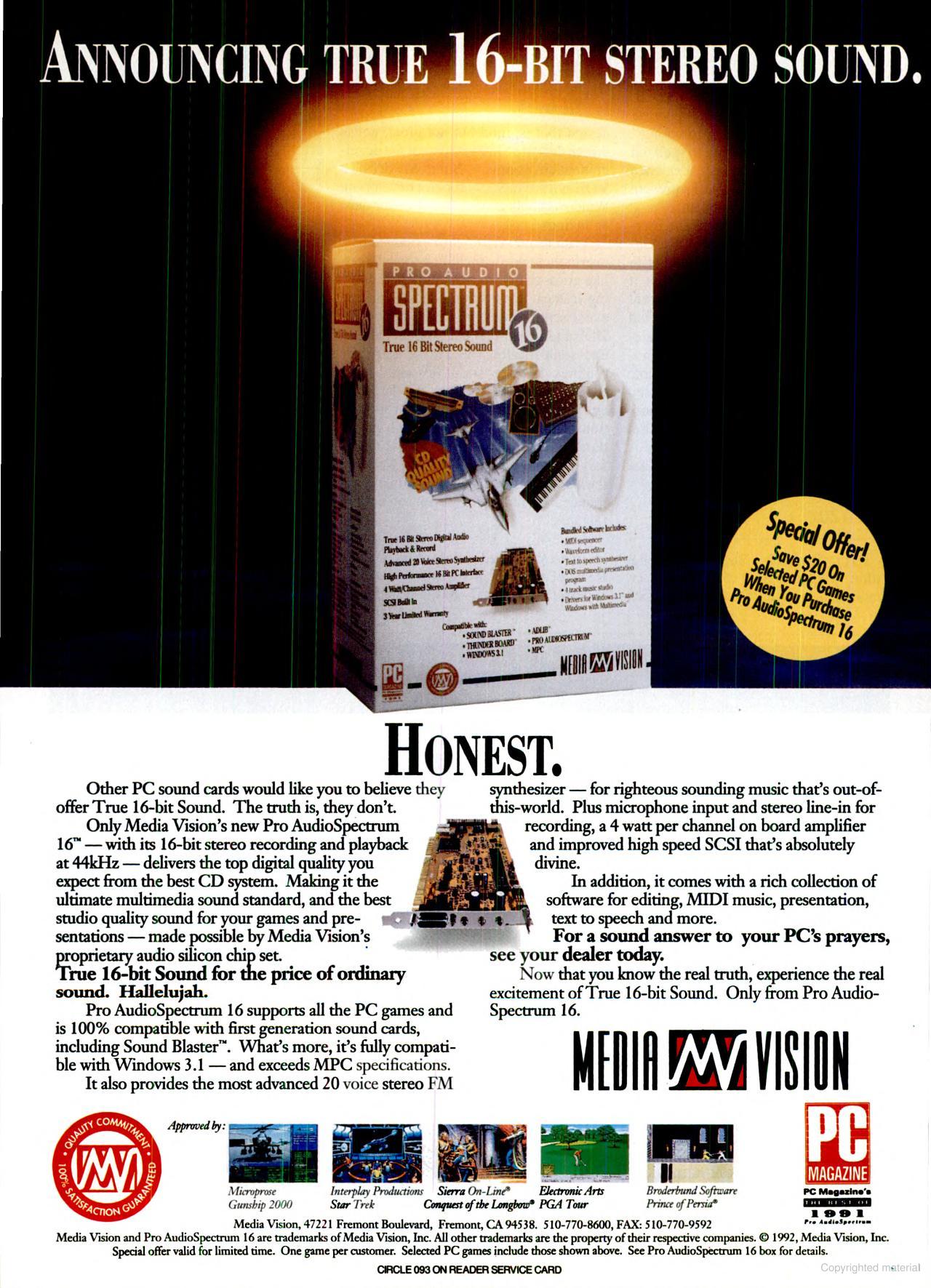
An advertisement for the Pro AudioSpectrum 16 in June 1992
This card is born to run games. It doesn't clutter itself with extra bundled software, CD-ROM interfaces, or thick manuals to wade through. The drawback is that it uses the Media Vision chipset, so if the reader dislikes these chipsets due to problems encountered with Sound Blaster compatibility, this may not be his of her card of choice. On the other hand, more and more companies are supporting the Media Vision chipset directly. Also, if one already has a CD-ROM host or SCSI drive, this card is easier to install (there are software configurable jumpers and no SCSI or proprietary CD-ROM hosts to conflict with existing hardware).
Though the documentation is a bit sparse, it should get the average user up and running with a minimum of difficulties."Computer Gaming World, October 1993
Setting it Up
All the MediaVision cards were pre-Plug & Play. Despite this, the PAS16 was one of the first cards to be almost completely jumperless. As was noted in Part 1 where I explored the different board revisions, it was clear MediaVision moved the location of certain jumpers and in some cases eliminated them completely (moving their selection into software).
The default settings for the card are 220h, IRQ 5, DMA 1 for the Sound Blaster side of things, and IRQ 7 and DMA 3 for the PAS16 portion.
For older games that needed Ad Lib's SOUND.COM to play Ad Lib sound, MediaVision wrote their own driver, called FM.COM.
Apparently a lot of software does *not* require the MVSOUND.SYS driver to be loaded, as they program the Pro Audio Spectrum directly. Perhaps MVSOUND.SYS is just for Ad Lib and Sound Blaster emulation?
If you're using the driver though, you should end up with something like these two lines in your startup files if you want Sound Blaster compatibility to work:
CONFIG.SYS
DEVICE=C:\PROAUDIO\mvsound.sys d:5 q:7 s:1,220,1,5 m:0 j:1
where:
d:5 = the DMA channel used by the PAS16 portion of the card (valid options are 0 through 7)
q:7 = the IRQ used by the PAS16 portion of the card (valid options are 2-7 and 10-15)
s:1,220,1,5 = the Sound Blaster settings
m:0 = MIDI port enabled/disabled (valid options are 0 for disabled and 1 for enabled)
j:1 = Joystick enabled/disabled (valid options are 0 for disabled and 1 for enabled)
v:75 = Initial volume setting (valid options are 0 through 100)
t:1 = Oscillator to use (valid options are 0 to use the motherboard's oscillator, 1 to use the on-board oscillator)
AUTOEXEC.BAT
SET BLASTER=A220 I5 D1 H1 P388 T6
Downloads
User Manual Get in touch if you can provide this missing item! |
PAS16 Driver/Utility Disks A copy of the original floppy disks shipped with the PAS16 by Mediavision. |
PAS16 Windows 3.x Drivers Windows 3.x drivers for the PAS16 by Mediavision.
|
PAS Utilities A collection of Pro AudioSpectrum series utilities and drivers |
|
|
More Pictures
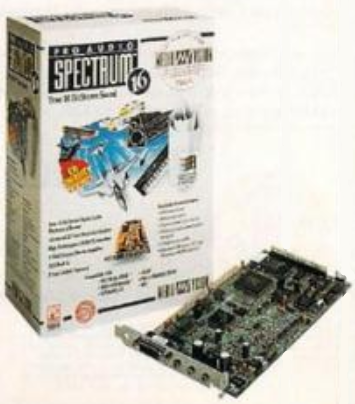
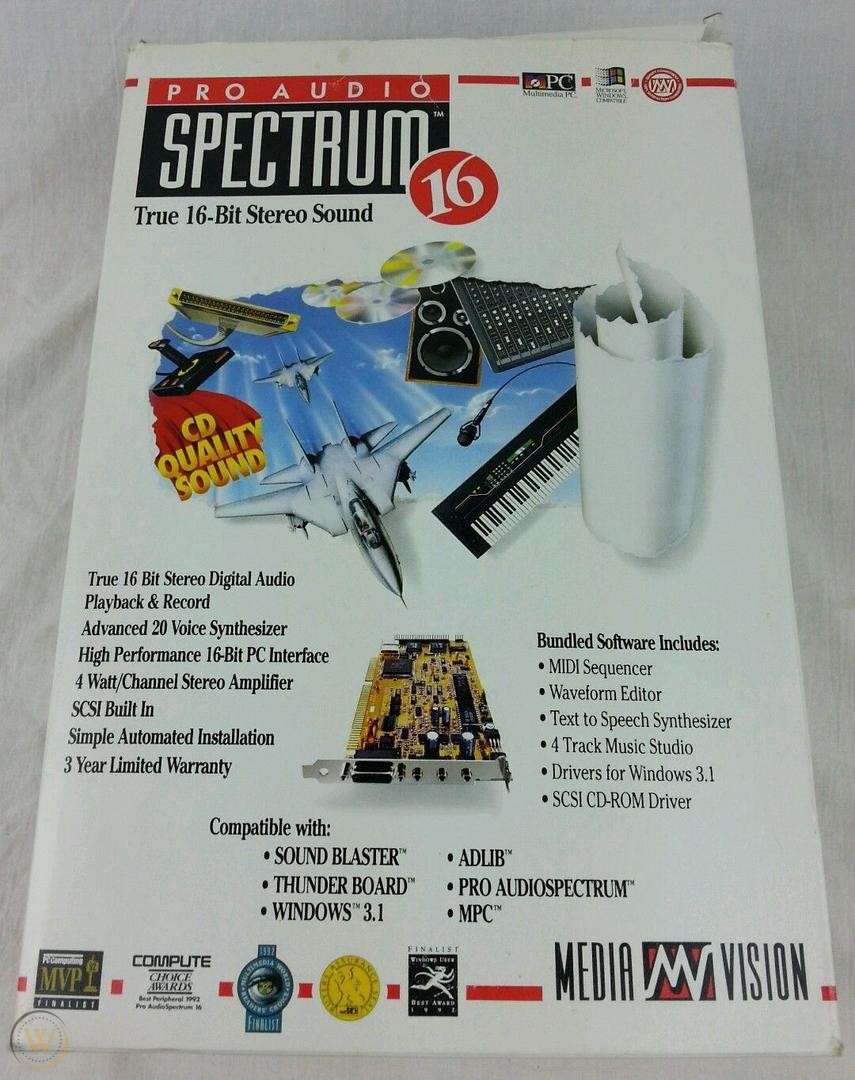
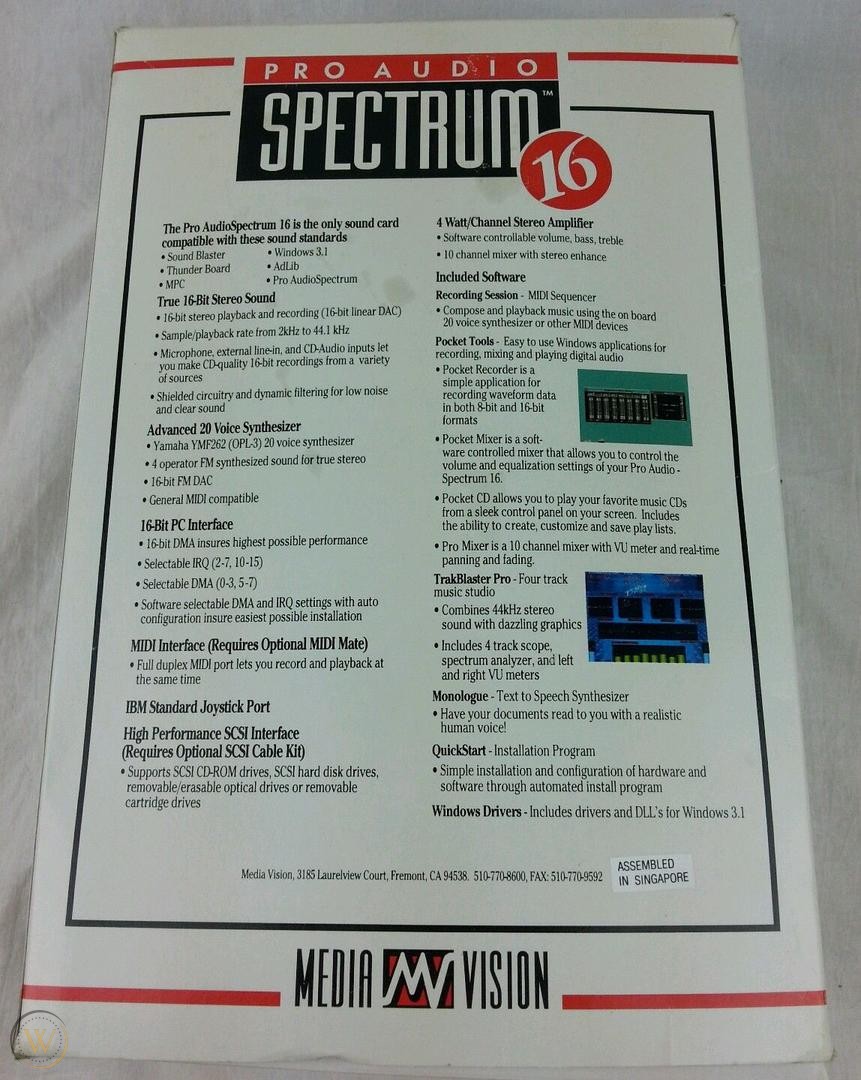
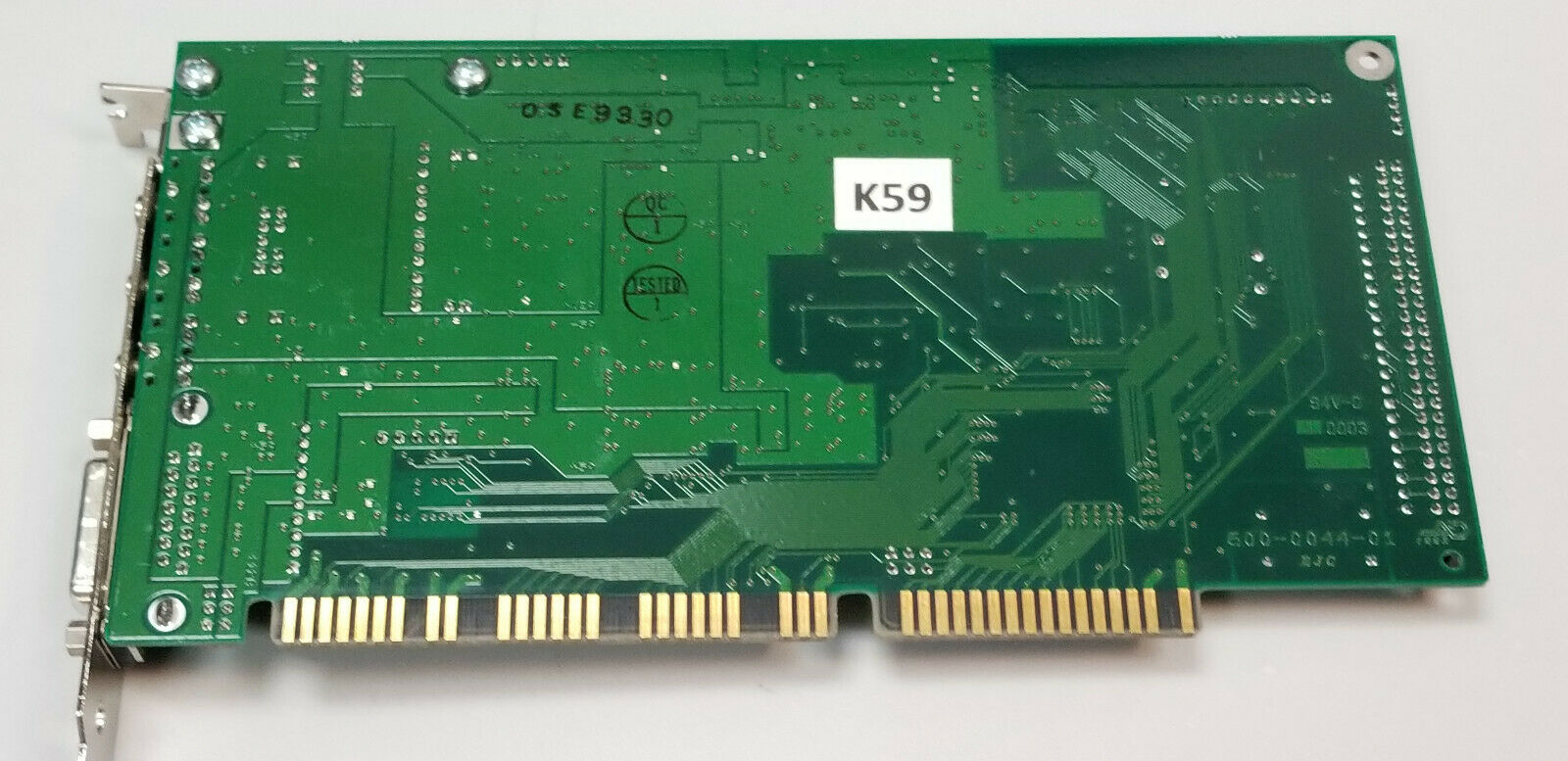
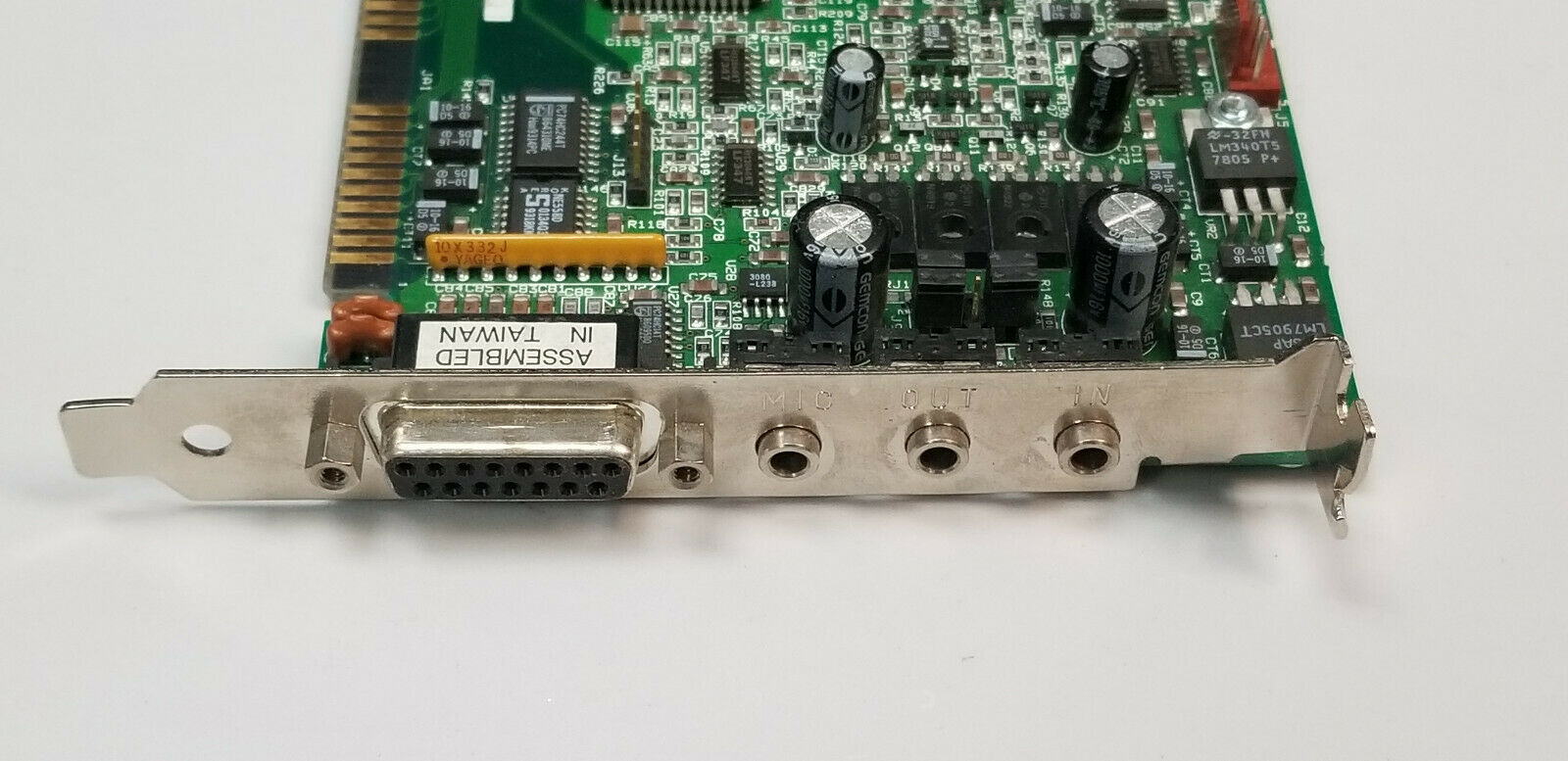
.png)
.png)
.png)
Credit to Dusko Marincic for the 3 images above of his PAS16 650-0022-01C card
.png)
.png)
.png)
and these three are of Dusko's extremely rare LMSI interface PAS16, 650-0082-03B card
.jpg)
.jpg)
The card above is owned by crizalis, and is a PAS16 Basic that is based on the LMSI PCB
